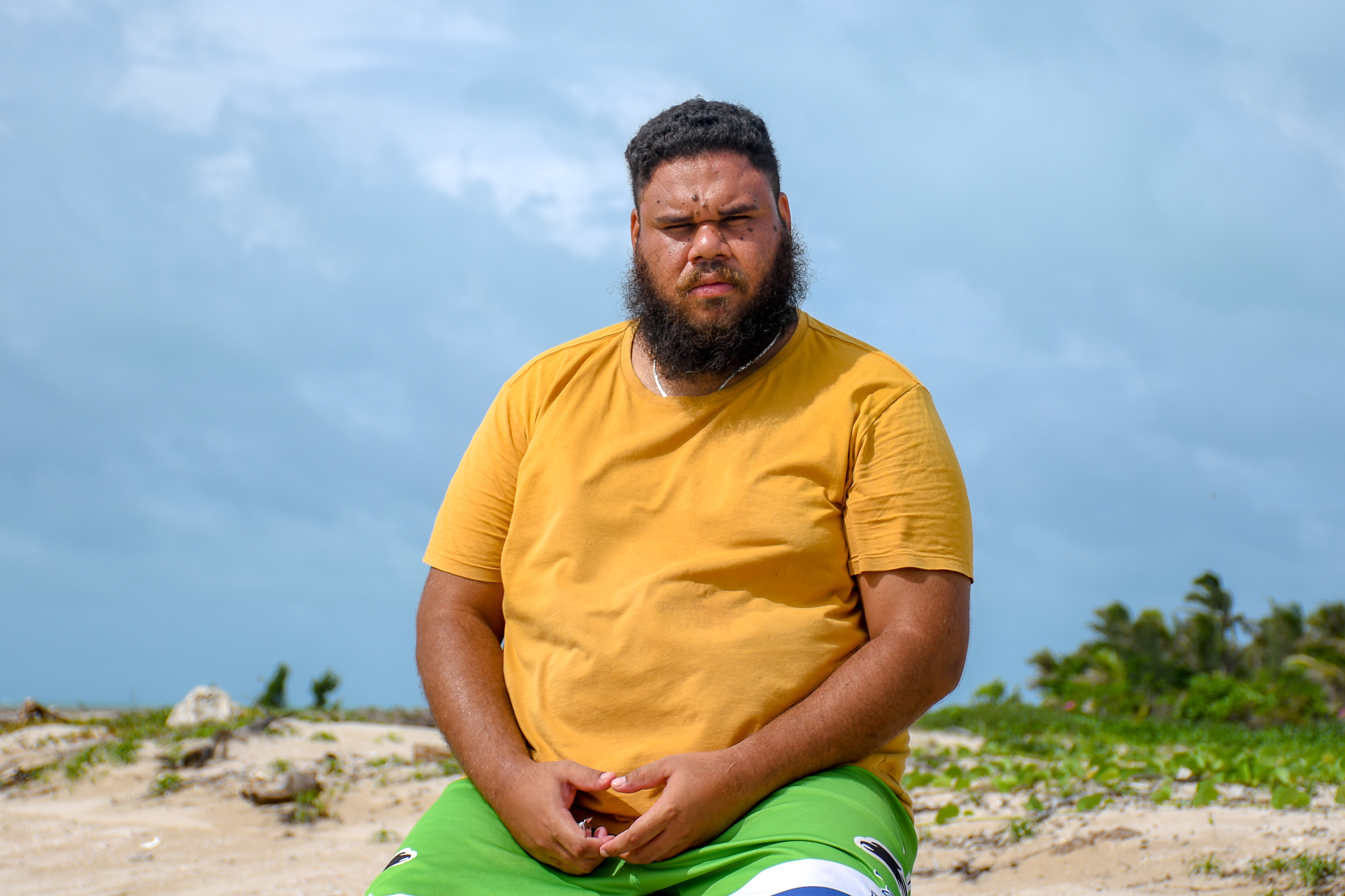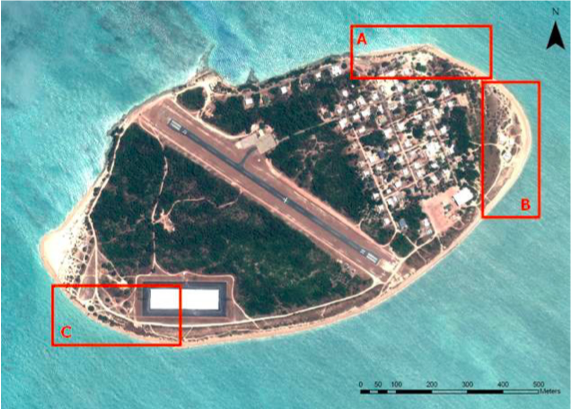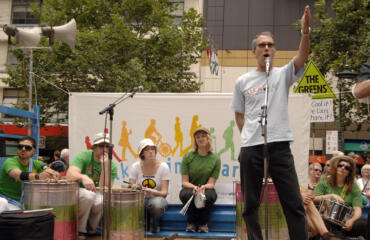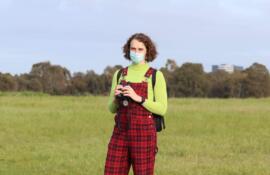Kabay Tamu slows his dusty white ute to walking speed on the dirt road that runs along the south-western shoreline of Warraber.
The tiny coral cay in the Torres Strait is home to about 250 people. It’s just 1.4km long, and half as wide, but shrinking at an alarming rate as rising sea levels allow increasingly powerful waves to batter the coast.
“This was the best spot for a day out,” the 28-year-old says, recalling his childhood. The houses on the island are all at the northern end, so this was the perfect place to escape.
Most of the beach where Tamu used to splash about with his friends is gone, along with several enormous Wongai trees that adorned the shoreline. They were a barrier of sorts, protecting the dirt road, and the dam across it and up a tiny hill, which supplies the island’s drinking water.
Now, the islanders dump their green waste to hold back seas that the Intergovernmental Panel on Climate Change (IPCC) estimates will rise 30-60cm with immediate cuts to carbon emissions, and 61-110cm by 2100 without. Some data suggests that sea levels in the Torres Strait could be rising at twice the global rate.

Warraber’s south-western shoreline at low tide. Kabay Tamu used come to this end of the island to play. Now, locals dump their green waste to protect the road and dam
A 2010 report by researchers from James Cook University found that “continued erosion may necessitate further action in the medium-term” to protect Warraber’s dam. If saltwater breaches it, life would be difficult to maintain.
Tamu, whose son is nine years old, says that future generations being forced from their homelands would lead to a trauma akin to what was caused by colonisation.
“Being removed, forcibly removed, from here, just because of rising sea levels and the effect of climate change, and becoming climate change refugees, it’s just something that really haunts my mind.”
He pulls his ute up again on the north-eastern side of the island, where the cemetery and church are separated from the sea by just a few broad strides. They are protected by a haphazard, failing defence, comprising rocks gathered in the early 2000s, coral, split sandbags and tyres.
A cost estimate for a new wall was put to a federal parliamentary inquiry by the Torres Strait Regional Authority (TSRA) in 2008 but work never eventuated. The locals are still waiting.
That means that Warraber man Danny Billy is constantly worried that the waves that already breach this makeshift wall will inundate his parent’s graves.
He says the erosion on the island has “put the fear in us”, and that he cannot bear the thought of leaving his ancestors behind.
“It’s our right to be here, to have a voice, to be recognised, and to make others realise this is our home … we have the right to live a healthy life, here, on our island.”
The Billy family name also appears on Warraber’s sister island, Poruma, where Danny spent part of his childhood. Just a 15-minute flight away, Poruma is smaller and skinnier – 400m wide and 1.4km long – but the erosion issues are similar.
On the western shore, a road and buildings are threatened, and 250 coconut trees – a symbol of the island, and a source of food, shelter and leaves used in traditional ceremonies – have already been washed away.

A fallen coconut tree is claimed by the sea on Poruma as high tide arrives
Local man Phillemon Mosby feels that loss keenly. The picturesque plantation should be a place to share with children and grandchildren, who would ordinarily take over the nurturing of the site.
“That experience was taken away because of climate change, because of the rising sea levels. We’ve seen areas where we used to go fishing that are no longer there. We’ve seen rocks where people used to go diving that are covered.”
Community elder Uncle Frank Fauid expresses the same sentiment as Billy and Tamu when asked about the potential for displacement.
Being denied the opportunity to walk, garden and fish in peace on homelands would be devastating, he says.
“We can’t leave here because we can’t leave our community and go live down south. The living system … is totally not the way we live up here.”
Tamu, Billy, and Uncle Frank’s cousin, Nazareth Fauid, are among the eight Torres Strait Islanders who lodged a complaint last May with the United Nations human rights committee against the Australian government, alleging that its failure to reduce emissions, or pursue proper adaptation measures across the region impedes their human rights, to culture and life.
Sophie Marjanac, a lawyer with environmental non-profit ClientEarth, is representing the group, who, above all else, want the government to meet its targets under the Paris Agreement, to reduce emissions by 65% below 2005 levels by 2030, to reach net zero by 2050, and to phase out thermal coal.
Last December, the federal government matched an earlier commitment of $20 million from the Queensland government for the construction of new seawalls in the strait, a step towards meeting the complainants’ demand for adaptation measures. But there is widespread scepticism among Islanders about when the new walls will be constructed.
In early 2018, emergency funding of $650,000 was granted to Poruma to protect its western shore, but the wall was built using geotextile sandbags with a 50-year life expectancy, rather than the rock or brick asked for by the community. The money was also not sufficient for the whole shoreline to be protected, which means more work is required. Where the coast remains exposed, coconut trees lie on the beach, their roots slowly ripping away from the island.
Alongside Poruma and Warraber, other islands including Boigu, Masig, Yam and Iama desperately need new seawalls. It is unclear which islands will be prioritised, and if the new funding will cover them all.
Meanwhile, the claimants demand for mitigation remains unaddressed. Tamu is quick to point out that “sea walls are only to buy us time” – the best fix is emissions reduction.
“The thing that got me was they [the federal government] didn’t announce it [the new funding] as seawalls to combat climate change. They said it was “an infrastructure development in the community”. They’re still trying to cover up climate change and the rising sea levels here.”
Tamu gained international headlines when he asked Prime Minister Scott Morrison to visit Warraber during the UN climate summit in New York last September. He maintains that the damage visible on Warraber and other islands would shock them into action on climate and coal.
“They would actually see for themselves how close the shoreline is to infrastructure and housing up here. And also, so a lot of the leaders can stop denying the connection between climate change and what’s happening to our planet.”
The invitation was rejected via email in November, and Tamu says that the government is still “hearing, but not listening” when it comes to nationwide pleas for climate action.
“We really want them to lead the way. If we change and go to more renewables and hit all the targets, it won’t change the world, it won’t change everything. But it will [mean] we’re leading the way and showing all the other countries that there’s another way to be.”
While the UN complaint won’t be settled until 2021, Danny Billy says islanders won’t stop making noise until Australia finally offers global leadership on climate change.
“We won’t stop until justice is served.”
Travel and research was supported by funding from the Melbourne Press Club’s Michael Gordon Fellowship program.
This story is co-published with Guardian Australia.

The length of Poruma’s western shoreline as high tide creeps closer.














